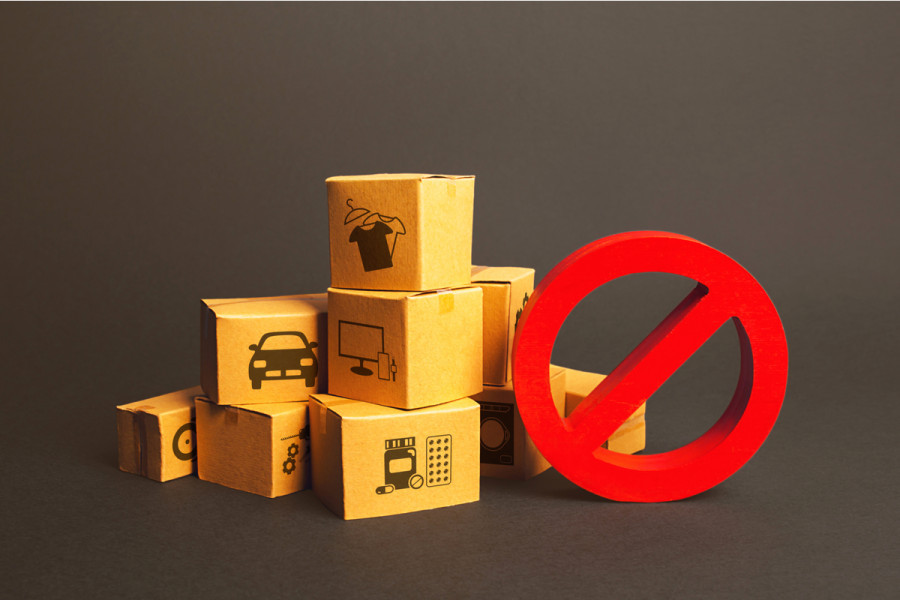Columns
Import ban impacts in Nepal
The negative consequences and long-term harms of import restrictions should not be overlooked.
Nischal Dhungel
Nepal primarily relies on imports to supply domestic demand. The ongoing Russia-Ukraine war and the resulting increase in prices of essential commodities like food, fuel and fertilisers have significantly impacted the country’s import-dependent economy. Nepal’s main imports include refined petroleum ($2.24 billion, 16 percent of total imports), followed by petroleum gas ($504 million, 3.75 percent), gold ($433 million, 3.23 percent), rice ($322 million, 2.4 percent), and soybean oil ($306 million, 2.2 percent), with India being the primary source for these goods. The rise in imports coincided with the demand-led recovery following Covid-19.
In response, without price mechanisms, the Government of Nepal imposed an import restriction on 10 different categories of luxurious goods on April 26, 2022. Additionally, the authorities directed commercial banks to refrain from issuing letters of credit to Nepali traders seeking to import luxurious goods, i.e., commercial banks must deposit 50 percent to 100 percent of the value of their imports in bank accounts. The central bank’s move came in the wake of mounting concerns related to Sri Lanka’s widening trade deficit, the soaring balance of payment deficit and declining inflows of remittances and foreign exchange reserves.
Restrictions and implications
The import restrictions initially imposed by the government appeared politically appealing, providing control over foreign exchange reserves and the economy. However, the International Monetary Fund (IMF) does not support these restrictions and suggests alternative policy instruments that are more favourable and effective in addressing economic challenges. Article VIII of the Article of Agreement of the IMF prohibits country members from imposing import bans, cash margins and obligations of letters of credit. These practices give rise to multiple currency practices. They operate as implicit devaluations against the IMF's policies because they create distortion and promote invoicing and smuggling.
In 2022, the import restrictions had a noticeable impact on recorded imports, resulting in a slowdown. The IMF analysis suggests that the bans led to a reduction of approximately 22 percent in imports, while mandatory letters of credit and margins resulted in around 11 percent decrease. However, these measures alone cannot address external pressures as a long-term solution. The banned items constituted only a maximum of 5 percent of total imports, while imports affected by mandatory letters of credit and margins accounted for approximately 23 percent. The reduction of roughly $80 million per month in imports was insufficient to address the underlying issues effectively.
After the government lifted a seven-month import ban on luxury goods on December 15, 2022, remittance inflow declined by 33 percent and stood at $3.65 billion. The number of Nepali workers seeking foreign employment fell by 7.5 percent to 236,779. Although the foreign reserves increased by 11.5 percent during the ban, rising from $7.76 billion in mid-April 2022 to $8.66 billion in mid-December, the reliance on import restrictions as a long-term solution remains unsustainable. The underlying causes of external pressures, such as high global commodity prices and robust domestic demand, require alternative approaches to ensure economic stability.
Economic implications
Import restrictions in Nepal have significant consequences for the economy. They lead to a decline in government revenue, foster opportunities for rent-seeking behaviour, contribute to inflationary pressures and undermine social trust. The limitations also affect crucial sectors like tourism and hospitality, as the lack of foreign alcohol impacts the hotel and restaurant industry and fuels illicit trade. Some goods are prohibited but do not consume significant amounts of foreign exchange. For instance, the restrictions on vehicle imports, which constitute a relatively small portion of total imports, contribute over one-third of customs duty revenues.
Consequently, although overall customs revenue remained relatively strong in FY 2021-22, it fell significantly short of the Department of Customs' target during the first six months of FY 2022-23, experiencing a decline of 51 percent. Had the government taken measures to boost the country’s vehicle (including EV) production, import restriction would make sense as domestic production would positively impact job creation. However, the immediate effect would only be seen when the country starts to manufacture e-vehicles in the country. This requires long-term planning and smooth facilitation from the government to pave the path for private sector development, mainly by investing in high-productivity sectors. Other factors, such as the rebound in tourism and the increase in remittances, also improved foreign reserves.
Moreover, the foreign reserve to handle merchandise imports rose from around seven months in April 2022 to 10 months in December 2023. It exceeded the central bank policy floor of seven months of import cover and the IMF's recommendation level of six months. The IMF appears more lenient than the NRB in assessing reserve adequacy. However, the IMF has a well-developed methodology for evaluating reserve adequacy, which is more complex than the NRB.
Some of the main weaknesses identified in the external sector statistics were an overestimation of goods imports; an underestimation of travel services exports, an underestimation of remittances, particularly those transmitted through informal channels, incomplete data on trade credit, making it difficult to reconcile flows and stocks; and the potential for inadequate coverage of external debt statistics. Both IMF and NRB estimates suggest that Nepal’s reserves are adequate.
Way forward
The government and NRB implemented temporary fiscal and monetary measures to address the trade imbalance, manage domestic demand and restore foreign reserves. As a result, the trade deficit was reduced, and the current account deficit stood at 1.5 percent of GDP in 2023 from 12.7 percent in 2022. This improvement can be attributed to lower import demand, decreased commodity prices and strong remittance and tourism income. However, the negative consequences and long-term challenges of import restrictions should not be overlooked. Some of these include negative impacts on industries, reduced foreign investment, reduced consumer choices and higher prices for imported goods.




 11.12°C Kathmandu
11.12°C Kathmandu















